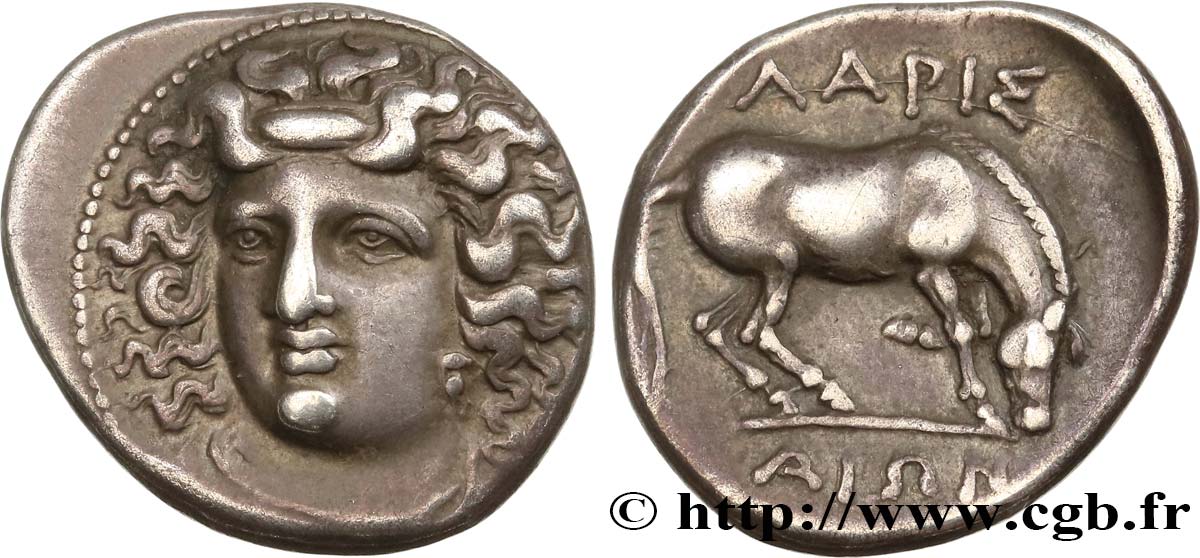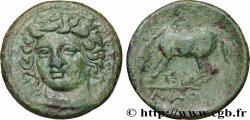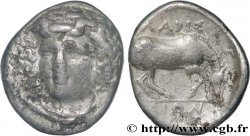Live auction - bgr_401661 - THESSALY - LARISSA Drachme
You must signin and be an approved bidder to bid, LOGIN TO BID. Accounts are subject to approval and the approval process takes place within 48 hours. Do not wait until the day a sale closes to register. Clicking on "BID" constitutes acceptance of the terms of use of cgb.fr private live auctions.
Bids must be placed in whole Euro amounts only. The sale will start closing at the time stated on the item description; any bids received at the site after the closing time will not be executed. Transmission times may vary and bids could be rejected if you wait until the last second. For further information check the Live auction FAQ
All winning bids are subject to a 18% buyer’s fee.
All winning bids are subject to a 18% buyer’s fee.
| Estimate : | 750 € |
| Price : | 780 € |
| Maximum bid : | 780 € |
| End of the sale : | 12 December 2017 14:12:43 |
| bidders : | 3 bidders |
Type : Drachme
Date: c. 350-340 AC.
Mint name / Town : Larissa, Thessalie
Metal : silver
Diameter : 19 mm
Orientation dies : 12 h.
Weight : 6,02 g.
Rarity : R2
Coments on the condition:
Exemplaire sur un flan ovale, avec le portrait légèrement décalé, le grènetis bien visible. Très belle expression du visage de la nymphe. Beau revers à l’usure superficielle. Très jolie patine de médaillier
Catalogue references :
Predigree :
Cet exemplaire provient de la vente Roma Numismatics IV (Londres), n° 1328 et du stock de D. F. Grotjohann (Münich)
Obverse
Obverse legend : ANÉPIGRAPHE.
Obverse description : Tête de la nymphe Larissa de face tournée de trois-quarts de face à gauche, les cheveux retenus par un bandeau (l'ampyx).
Reverse
Reverse description : Cheval paissant à droite, l'antérieur repose sur la ligne de sol ; plante sous le cheval.
Reverse legend : LARIS//AIWN
Reverse translation : (de Larissa).
Commentary
Cet exemplaire, sur un flan relativement étroit tout en étant relativement complet, nous montre la maîtrise artistique du graveur qui a su habilement adapter son sujet à la forme circulaire du flan, tant au niveau du droit, où la chevelure vient harmonieusement occuper l’ensemble du flan et au revers, où le cheval semble se courber. Cette position où le cheval pose l’antérieur sur le sol semble beaucoup plus rare que ceux où il est carrément courbé avec le même antérieur plié.
This example, on a relatively narrow flan while being relatively complete, shows us the artistic mastery of the engraver who knew how to skillfully adapt his subject to the circular shape of the flan, both on the obverse, where the hair harmoniously occupies the entire flan and on the reverse, where the horse seems to bend. This position where the horse places the foreleg on the ground seems much rarer than those where it is completely bent with the same foreleg bent
This example, on a relatively narrow flan while being relatively complete, shows us the artistic mastery of the engraver who knew how to skillfully adapt his subject to the circular shape of the flan, both on the obverse, where the hair harmoniously occupies the entire flan and on the reverse, where the horse seems to bend. This position where the horse places the foreleg on the ground seems much rarer than those where it is completely bent with the same foreleg bent








 Report a mistake
Report a mistake Print the page
Print the page Share my selection
Share my selection Ask a question
Ask a question Consign / sell
Consign / sell
 Full data
Full data











